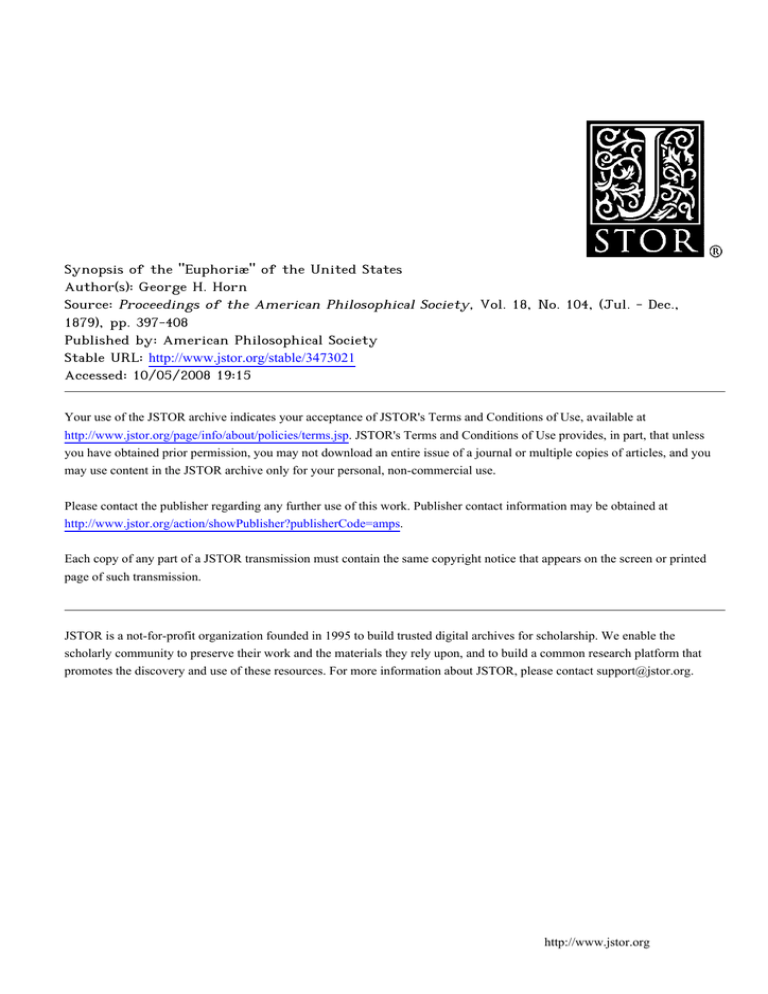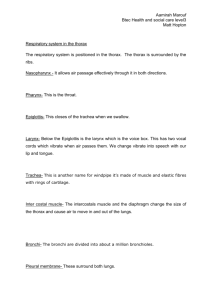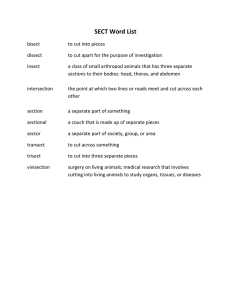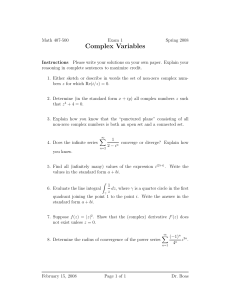George H. Horn Source: Proceedings of the American Philoso
advertisement

Synopsis of the "Euphoriæ" of the United States Author(s): George H. Horn Source: Proceedings of the American Philosophical Society, Vol. 18, No. 104, (Jul. - Dec., 1879), pp. 397-408 Published by: American Philosophical Society Stable URL: http://www.jstor.org/stable/3473021 Accessed: 10/05/2008 19:15 Your use of the JSTOR archive indicates your acceptance of JSTOR's Terms and Conditions of Use, available at http://www.jstor.org/page/info/about/policies/terms.jsp. JSTOR's Terms and Conditions of Use provides, in part, that unless you have obtained prior permission, you may not download an entire issue of a journal or multiple copies of articles, and you may use content in the JSTOR archive only for your personal, non-commercial use. Please contact the publisher regarding any further use of this work. Publisher contact information may be obtained at http://www.jstor.org/action/showPublisher?publisherCode=amps. Each copy of any part of a JSTOR transmission must contain the same copyright notice that appears on the screen or printed page of such transmission. JSTOR is a not-for-profit organization founded in 1995 to build trusted digital archives for scholarship. We enable the scholarly community to preserve their work and the materials they rely upon, and to build a common research platform that promotes the discovery and use of these resources. For more information about JSTOR, please contact support@jstor.org. http://www.jstor.org 1879.] 397 rHorn. Bibliography and Synonymy. C. planatus Lee. New Species, 1863, p. 81. depressusHorn. Trans. Am. Ent. Soc. 1871, p. 340 (deformity). C. saucius Lec. Journ. Acad. 1858, 4, p. 16. C. Wheeleri Lec. Wheeler's Report, 1876, p. 516 (App. H, 10). C. leucostictus Burm. Handb. III, p. 677. polita Schaum. Ann. Ent. Soc. Fr. 1844, p. 897. C. Schaumii Lec. Proc. Acad. 1853, p. 231. crassipesWestw. Thesaurus, p. 204; Trans. Ent. Soc. London, 1878, p. 30, pl. i, fig. 6. C. Westwoodi, n. sp. Schaumiit Westw. Thesaurus Entom. Oxon. 1874,p. 65, pl. xiv, fig. 3. C. angularis Lec. Pacif. R. R. Rep. 1857, App. 1, p. 37. ? armatus Walker, Naturalist in Vancouver, II, p. 320. C. pilosicollis Horn. Trans. Am. Ent. Soc. 1871, p. 341. C. crinitus Lec. Trans. Am. Ent. Soc. 1874, p. 55. C. Knochii Lec. Proc. Acad. 1853, p. 231. crenicollisWestw. Thesaurus, p. 65, pl. ii, fig. 6. C. nitens Lec. Proc. Acad. 1853, p. 232. C. variolosus Kby. Zool. Journ. II, p. 516; III, p. 152, pl. v, fig. 4-6. castanecet G. et P. Mon. p. 118, pl. xvi, fig. 7. Sayi Harris. Jour. Acad. V, p. 388. PercheroniWestw. Thesaurus, p. 61, pl. ii, fig. 5. cicatricosusWestw. loc. cit. p. 60, pl. xiv, fig. 7. C. squamulosus Lec. Journ. Acad. 1858, IV, p. 17. junior Westw. Thesaurus, p. 61, pl. xiv, fig. 8. C. canaliculatus Kirby. Zool. Journ. III, p. 151, pl. iii, fig. 5, c, d. castaneaet Schaum. Germ.Zeits. III, p. 255 ; Burm. Handb. III, p. 681. Hentzii Harris. Jour. Acad. V, p. 386. C. retractus Lec. Trans. Am. Ent. Soc. 1874, p. 54. WalshiiWestw. Thesaurus, Entom. Oxon. Oxford, 1874, p. 60, note. C. castaneee Kn. Neue Beitr. p. 115, pl. iii, fig. 1. LeconteiWestw. loc. cit. p. 60, note. C. Harrisii Kby. Zool. Journ. III, p. 152, pl. v, fig. 3a; Schaum, Germ. Zeitschr. III, p. 254; Burm. Handb. III, p. 680. castanecet Kby. Zool.Journ. II, p. 517; Harris,Journ. Acad. V, p. 384. Synopsis of the EUPHORIAE of the United States. BY GEORGEH. HORN, M.D. (Read before the American Philosophical Society, Dec. 19, 1879.) The occurrenceof several new speciesin our fauna affordsan opportunity of briefly reviewing our entire series. The first question presenting itself is the generic name which should be adopted, and this seems to be a difficultmatter to determine. The ablest European authoritieswho have had to deal with the Cetonia group as a PROC. AMER. PHILOS, SOC. XVIII. 104. 2y. PRINTED JAN. 2, 1880. Horn.] 398 f[lec. 19 whole do not seem to be in accord as to the limits of genera, so that we have on the one hand a multiplicity and on the other a synonymic union which does not seem tenable. Lacordaire, under the name Euryomia, collects the contents of about ten genera, all of which, with one exception, are the creation of Burmeister. This aggregation is again dispersed in the Catalogus (G. and H.) with Erirhipis alone suppressed. It seems highly probable that neither of these extremes is correct. The name Euryomia, at present used in our literature, has for its type a Madagascar species, which presents characters entitling it to be separated from the forms which occur in our fauna, whatever may be its relations with the other old world types which Lacordaire has united with it, consequently our species should bear some other name. Euphoria is adopted as most convenient, because the name suggests no special character. Lacordaire states that the genus is not capable of being defined, seeing that the species differ more among themselves than they do in the aggregate from the other neighboring genera. It is, he says, "a genus established on geographical distribution alone." In a limited series, such as our fauna presents, Stephanucha might be allowed to remain separated, but this seems hardly necessary until the limits of all the genera are better defined than they are now. Having given the reasons for adopting the generic name, the following table of species is presented for the consideration of our students: Clypeus dentate in front. Base of thorax entire. Fabr. .....................areata Quadridentate [STEPHANUCHA] .. .. verticalis, n. sp. Bidentate ..... ............... ....... Clypeus entire or feebly emarginate, the angles rounded. Mesosternal protuberance round or nearly so .....2.............. 2. Mesosternal protuberance transverse .. .......... .............11. 2. Thorax either shining or punctured and pubescent . ................3. Thorax opaque, scarcely punctured, not pubescent ..............10. 3. Base of thorax at middle not emarginate ..........................4. Base of thorax emarginate at middle ............................. 5. 4. Thorax arcuate at base, elytra not sulcate. ........... aestuosa, n. sp. . Kernii Hald. Thorax truncate at base ............................ 5. Punctuation of thorax dense, surface pubescent or hairy ...........6. 7. Punctuation sparse, surface glabrous or scarcely pubescent......... n. sp. 6. Body beneath and legs very hairy ..................hirtipes, Body beneath and legs normally hairy ............ sepulcralis Fabr. 7. Mesosternal protuberance punctured and hairy beneath..devulsa, n. sp. Mesosternal protuberance glabrous beneath .... ...................8. 8. Punctuation of thorax coarse, elytra with short and inconspicuous ............. telancholica G. & P. pubescence ................. Punctuation of thorax sparse, usually inconspicuous, body above entirely devoid of pubescence ..................................9. 9. Elytra reddish-yellow with black fascia ...,a..........fascifera Lee. Elytra variable, the surface with green or blue lustre.. .fulgida Fabr. 1879.] 399 [Horn. 10. Clypeus longer than wide, rather deeply emarginate. .californica Lee Clypeus not longer than wide, feebly or not emarginate. .herbacea Oliv. 11. Elytra luteous, maculate with small black spots ............inda Linn. Elytra sooty, with small transverse luteous spots ....... Schottii Lec. From the above table I have rejected basalis, dimidiata and canescens, as they are Mexican, and are very rarely found in Texas or Arizona. The species described by Say as Cetonia vestita is believed to be C. hirtella Linn. (Schaum, Am. Ent. Soc. Fr., 1849, p. 267), and nothing has ever been found since in our country which will fill the description, it is therefore dropped into European synonymy. Fab. E. areata Black, moderately shining, elytra luteous with black spaces at the humeri, and subapical umbone and along the suture, upper surface with short erect yellowish pubescence, longer on the liead, denser on the thorax and very sparse on the elytra, beneath hairs long and sparse. Clypeus short, narrowed in front, quadridentate, the middle teeth closer and arising from a common base. Thorax oval, base arcuate entire, surface densely punctured. Elytra very obsoletely bicostate, the punctuation very indistinct. Mesosternum feebly prominent, the protuberance transverse. Pygidium usually moderately, densely punctured. Abdomen with very few punctures. Length .48 inch; 12 mm. The club of the male antennae is a little longer than that of the female. The anterior tibiae are tridentate in both sexes. The normal form of coloration, and which is almost invariable in the eastern specimens, is that in which the elytra are in great part luteous, with the base narrowly black, the suture is also black, this color dilating into a large circum-scutellar patch, a smaller transverse space behind the middle, and again dilating at apex. In the specimens from Kansas and Nebraska, the elytra are more roughly sculptured and almnostentirely black, the luteous color being reduced to a U-shaped mark by the extension of the elytral black spaces, and by the margin being dark. A specimen in Mr. Ulke's cabinet requires special mention. It is of the size of aestuosa, the humleri and subapical umbone are similarly tipped with piceous, and the suture very narrowly piceous, disconnected from the suture and along the region occupied by the faint costee are irregular small piceous patches. The sides of the thorax are irregularly bordered with a whitish coating, and the pygidium Horn.] 400 [Dec. 19, except at tip clothed with similar material. The clypeus is formed as in nornial areata,and the charactersgenerally are those of that species. From its appearanceit might be suspected of being a hybrid between aestuosaand areata. Occursfrom the Middle States, westward to Kansas, and south to Texas. E. verticalis, n. sp. Black, moderately shining, upper surface without pubescence, form robust, moderatelyconvex. Clypeus as long as wide, a little narrowedin front, anteriorlyemarginate, the angles acute and reflexed, vertex with an obtuse tubercle, surface of head coarsely, densely and deeply punctured. Thorax oval, narrowedin front, broaderthan long, sides strongly arcuate, especially in front, base less arcuate, not emarginate,disc moderately convex with coarse punctures sparsely placed, but closer near the anterior margin, a narrow smooth median space. Scutellum smooth. Elytra onehalf longer than the thorax, disc with rows of ocellate fovese forming nearest the suture two distinct pairs separated by very feeble costae,between the ocellate foveseare simple puncturesdistantly placed, at the sides the puncturesare irregular,and more densely placed; suturalangle obtuse. Pygidium sparsely punctate. Body beneath with brownish hair, abdomen nearly smooth, a few coarse puncturesat the sides only. Length .52 inch; 13 mm. P1. iv, fig. 12. Tlhe sexes differ only in the form of the pygidium, that of the male being more convex and inflexed at tip. The anterior tibiae are acutely tridentate, the upper tooth more distant than the other two. The antennal club is nearly as long as the entire stem in both sexes. The mesosternal button is transversely oval and hairy in front. In general form this species resembles areata, but is a little more robust. It is easily known among the species in our fauna by its bidentate clypeus and totally black color, as well as by the elytral sculpture. By its form of clypeus it is allied to E. Hera Burm. from South America. Two specimens are before me, one of each sex from Arizona, and the adjacent portion of California. E. aestuosa, n. sp. Piceous, moderately shining, body above luteous, thorax with a large median piceous space, humeral and subapical umbones of elytra tipped with piceous, form moderately robust, surface above and beneath with short, inconspicuouspubescence. Clypeus a little wider than long, slightly broaderin front, angles rounded, anterior margin moderately reflexed and 401 1879.] [Horn. slightly emarginateat middle. Head and front coarsely and densely punctured with moderatelylong hair. Thorax oval, narrowedin front, slightly wider than long, sides moderately arcuate, base not narrower than middle, basalmarginregularlyarcuate,surfacecoarsely and densely punctured, with short erect yellowish pubescence. Scutellum smooth. Elytra moderately convex, disc very vaguely bicostate, surface irregularly sparsely punctate. Body beneath piceous, shining, sparselyhairy, tibiaevery feebly fimbriate. Pygidium concentrically strigose, smooth near the tip. Mesosternalbutton round, hairy. Length .54 inch; 13.5 mm. P1. iv, fig. 14. In the unique ? before me, the club of the antenna nearly equals the stem. The anterior tibiae are acutely tridentate, the teeth rather long and equidistant. From the few species in our fauna which have the base of the thorax simply arcuate, this species differs, either by the form of the clypeus or the elytral and thoracic sculpture. One specimen, Kansas, given me by Dr. S. V. Summers. It is probable that the color will vary from this unique. The scutellum is black, and the suture and apical margin narrowly piceous, and these spaces may possibly be found extending so as to form a style of coloration analogous to that of areata. E. hirtipes, n. sp. Piceous, elytra luteous, above with moderately long yellowish hair. Clypeus as broad as long, not narrowed in front, anteriorangles broadly rounded, apical marginslightly reflexed,feebly emarginate. Head coarsely and densely punctured, clothed with rather long yellowish hair. Thorax oval, broader than long, narrower in front, sides strongly arcuate, base narrowerthan middle, the margin broadly arcuate,and opposite the scutellum emarginate, disc moderately convex, surface densely but rather irregularly punctured, a smooth space along the middle and one on each side, pubescence rather long and erect. Scutellum smooth, a median impression near the tip. Elytra slightly narrowedtoward the tip, disc feebly convex, vaguely bicostate, the intervals irregularly punctured, the punctures bearing moderatelylong hairs. Pygidium moderately densely punctured and hairy. Body beneath and legs clothed with long yellowish hair. Abdomen coarsely punctured. Mesosternal button round and hairy in front. Length .42j-.56 inch; 10.5-14 mm. PI. iv, fig. 13. The antennal club is about the length of the stem, and similar in the two sexes. The anterior tibike are rather broad, tridentate, the apical tooth longer and more distant than the other two. The legs are less hairy in the female 402 Horn.] [Dec. 19, than in the male,which has, especiallyon the hind tibiae,a densebrushof long hair on the innerside. In form,this species bears a resemblanceto sepulcralis, but so differsin color and vestiture,not onlyfromthis, but also fromall our others, as to make it very conspicuously distinct. Occursin Dodgecounty,Nebraska. E. Kernii Hald, This species has become so generally known as to need no extended description. The clypeus is nearly square, the angles rounded, the anterior margin feebly emarginate. The thorax is transverselyoval, base truncate at middle, surface densely and coarsely punctured. The elytra are each rather broadly and deeply bisulcate, the surface sparsely punctate and at the sides transversely wrinkled. The pygidium is concentricallystrigose. The mesosternumdoes not project in a button-like protuberance. Length .40-.52 inch; 10-13 mm. The maleantennalclub is a little longerthan that of the female. The anteriortibiaeare very decidedlytridentatein the femaleand either simplybidentatein the maleor with the uppertooth showinga very feebletrace. No species in our fauna exhibits such a wide range of colorvariation. In the normalformthe undersurfaceand legs are piceous or black. Iead black. Thorax black,sides morewidely, basevery narrowlyborderedwith yellow. Elytra in great partyellow or reddish-yellow,maculatewith black spotsof irregularsize and shape,becomingmoreor less confluent. The firstnoticeablevariety(ClarkiiLee.)hasthe abdomen, posteriorlegs and the anteriorfour tibie pale reddish-yellow. The discal blackspaceof the thoraxis divided by a pale medianstripe,the elytraremainingnormalin color. Fully as commonas this last varietyis one in which the entirebody aboveand beneathis black. These last formsresemblethe species describedfurther on as devulsa,but this has the base of thorax emarginate. Occurs over the region of the Plains from Kansas to Texas. E. devulsa, n. sp. Piceous black, shining, sparsely clothed with very short inconspicuous 1879.] 403 [Horn. pubescence. Clypeus a little wider than long, sides feebly arcuate, anterior angles broadly rounded, apical margin slightly reflexed and feebly emarginate at middle. Head coarsely and densely punctured, more sparsely on the clypeus. Thorax oval, narrowed in front, broader than long, sides regularly arcuate, basal margin emarginate at middle, disc moderately convex, coarsely but not densely punctured. Scutellum coarsely punctured at the sides. Elytra moderatelyconvex, sub-bicostate on the disc, the intervals with variolate fovea, which gradually become simple punctures toward the sides of the elytra, sutural angle rectangular. Body beneath sparsely clothed at the sides with yellowish hair, abdomen very sparsely punctate and with few hairs at the sides. Tibiae slightly fimbriatewithin. Pygidium concentrically strigose. Mesosternal button punctured and hairy beneath and in front. Length .40cJ-.48 inch; 10-12 mm. P1. iv, fig. 15. The anterior tibiae are tridentate in the two sexes, the upper tooth more distant. The antennal club is very nearly as long as the rest of the antennae. This species resemblesthe Mexican E. dimidiatain form, sculpture and size, and differs in the style of coloration and the punctured scutellum. It also resembles the entirely black varieties of Kernii, but the latter lias more deeply sulcate elytra and the thorax truncate at base. The males differ from the females by their smaller size, narrowerform and more convex pygidium. Occursnear San Antonio, Texas. E. sepulcralis Fab. Body beneath bronzed,shining, distinctly violaceous, above dark bronze, not very shining. Clypeus a little wider than long, anteriorangles rounded, apical margin slightly reflexed,not emarginate,surfacecoarsely punctured, vertex with short erect yellow hairs. Thorax transversely oval, sides arcuate, base emarginateat middle, surface coarsely punctured, not densely at middle, but densely and subconfluentlyat the sides, pubescence short, erect and very persistent. Scutellum usually smooth, often sparsely punctured at the sides. Elytra distinctly bicostate, intervals with numerous punctureswhich tend to become ocellate foveae,at sides the puncturesare converted into short, deep transversestrigee,especially near the apex, surface sparsely pubescent with numerous short, sinuous lines of whitish or ochreous color; tip of elytra distinctly sinuous, the suture slightly prolonged. Pygidium concentricallystrigose, often whitish at the sides. Mesosternal umbone transversely oval. Metasternumsmooth at middle, strigose, and often coated with white at the sides. Abdomen sparsely punctured at middle, at sides more coarsely and with few hairs, often with whitish coat. Length .44-.60 inch; 11-15 mm. Horn.J 404 [Dec. 19, The club of the male antenna is very little longer than that of the female, the anterior tibiae tridentate in both sexes. This species is, next to inda, the most common in our fauna. It occurs from the Middle States westward to Kansas, and to Florida and Texas, extending even into Mexico. The above description,rather detailed for one so common, is given that the specific limits when comparedwith melancholicamay be made more evident. E. melancholica Gory. Body beneath black, shining, usually with green or dark blue lustre, upper surface equally shining, surface greenish-blueor nearly black. Clypeus as in sepulcralis, head not hairy. Thorax formed as in that species, the punctuation coarse, denser at the sides but not confluent, the surface entirely devoid of hairs. Elytra also similar, the punctuationless deep and more sparse, and at the sides very faintly or not at all strigose, surface devoid of hairs, and with whitish lines similar to those of sepulcralisbut less sinuous. Body beneath as in sepulcrais. Length .48-.60 inch; 12-15 mm. The antennal club of the male is very distinctly longer than that of the female. The anterior tibiaeare tridentate in both sexes, but the upper tooth is smaller in the male. By a comparisonof descriptions it will be seen that this species is more shining, less deeply sculptured,and the upper surface without pubescence. The sculpture of the thorax and sides of elytra is notably different in the two. Here the sides of the thorax are usually margined with cretaceous, but in sepulcralisrarely so. The sexual characters here are also better marked. Occursin Kansas, Texas and Mexico. E. fascifera Lee. Black, shining, glabrous. Clypeus as broad as long, anterior angles rounded, margin reflexed, not emarginate, surface coarsely and densely punctured. Thorax triangular, sides feebly arcuate, base emarginate in front of scutellum, apex truncate, the middle of apical margin slightly elevated in a tubercle, surfacesparsely punctate, color reddish-yellow, with a large triangularblack space, or with the space replaced by four black spots. Elytra vaguely bicostate, punctures sparse and coarse, on the disc sub-ocellate,color a reddish-yellow, with a basal, median and sub-apical transversedentate fascialblack. Pygidium concentricallystrigose. Body 1879.] 405 [Horn. beneath very coarsely transversely strigose, and with sparse short pubescence. Abdomen very sparsely punctate, and slightly pubescent at the sides. Mesosternal umbone moderately prominent, rounded at tip. Length .52-.74 inch; 13-19 mm. P1. iv, fig. 16. The club of the male antenna is a little longer than that of the female; anterior tibive tridentate in both sexes. The specimens before me, six in number, are exactly alike in their elytral markings, scarcely varying in the minutest detail; in one in my cabinet, from Utah, the thorax has the large black discal space replaced by four smaller spots. The entirely glabrous surface and the general outline of this species place it in close alliance with fulgida. Occurs in the Peninsula of California, and extends to South-western Utah at St. George (Dr. Palmer). E. fulgida Fab. This species, well known fromits brilliant green surface,varying to blue, needs but little comment. The upper surface is entirely devoid of pubescence. The head is brilliant green, the thorax similar in color, but margined at the sides with yellow, its surface sparsely punctate. On the elytra the traces of costse are almost entirely obliterated, the punctuation usually sparse and indistinct, often more or less maculate, with cretaceous spots. The pygidium is concentrically strigose, and with four cretaceous spots more or less confluent. The metasterumis smooth at middle, and at sides deeply strigose. The abdomenis smooth, with but few coarse punctures at the sides, and along the margin of the segments, the sides are usually broadly cretaceous, sometimes with a double row of cretaceous spots. The mesosternalumbone is prominent, oval at tip. The legs are reddishor brownish-yellow,tarsipiceous. Length .52-.80 inch; 13-20 mm. The male has a larger antennal club than the female, the tibihe are tridentate in both. In the specimens from the Northern States, the elytra have less of the greenish surface lustre, and exhibit a brownishred ground color; these have also the fewest whitish spots. In the specimens from the Gulf States, the color is always more brilliant, the punctuation more evident, and the whitish spots more numerous. Occurs from the Middle States westward to Missouri, and south to Florida and Texas. Lec. E. californica Bright green, opaque above, shining beneath, very similar to fulgida, upper surface without pubescence. Clypeus longer than wide, slightly PROC.AMER. PHILOS. SOC. XVIII. 104. 2z. PRINTED JAN. 3, 1880. . Horn.] A/n tVu [Dec.19, narrower in front, apical margin deeply emarginate, feebly reflexed, surface not densely punctured. Thorax transversely oval, sides rather strongly arcuate, base emarginate at middle, disc moderately convex, sparsely obsoletely punctured, a small white spot on each side of middle, lateral margin very narrowly cretaceous. Elytra obsoletely bicostate, the punctures between the costee very fine and in two rows, sides rather strongly plicate, suture rather strongly elevated, especially near the tip, where it is slightly prolonged, surface opaque green with small cretaceous spots, the first at middle on the inner costa, the second at three fourths, between this costa and the suture, a third behind the second near the apex, two at the margin placed obliquely behind the first two, a very slnall spot behind the humerus. Pygidium strigose, a white spot each side. Body beneath shining green, sparsely clothed with hair along the sides. Metasternumand abdomen smooth at middle, coarsely punctured at the sides. Meso-metasternalprotuberancelong, parallel, roundedat tip. Legs bright green, tarsi black. Length .64 inch; 16 mm. Of this species I have seen but one specimen, the type. It was given by Baron Osten-Sacken to Dr. Leconte, with the statement that he obtained it in California, but I do not know if it was collected by him. The species seems to me to resemble the East Indian type and to belong to the genus (?) Glyciphana, but until an opportunity is afforded for comparison no positive statement can be made, and I leave it with the doubts above given. E. herbacea Oliv. Body beneath green, moderately shining, above dull green, changing to opaque brown. Clypeus as broad as long, sides and apex reflexed, the latter not emarginate, surface sparsely punctate. Thorax transversely oval, sides moderately arcuate $, or more triangular with sides nearly straight 3, base emarginate at middle, disc sparsely punctate. Elytra vaguely bicostate,intervals finely punctate, sides with coarsestrigte, surface variable from brownish-green to brown, opaque, with numerous whitish spots of irregular size and shape behind the middle and near the apex and sides. Pygidium concentrically strigose and with short hairs. Body beneath green, shining, abdomen often brownish. Metasternum smooth at middle, strigose and hairy at the sides, abdomen sparsely punctate over the entire surface,pubescent at the sides. Mesosternalbutton oval, a little broaderthan long. Length .56-.64 inch; 14-16 mm. The male club is very decidedly longer than that of the female, the anterior tibiae tridentate in both sexes. This species is entirely devoid of pubescence on the upper surface, except the head and pygidium. It is a well-known species to all collectors, but less common than inda. 1879.] 407 [Horn. Occurs in the Middle States region, occasionally found abundantly, but usually not common. E. inda Linn. Clypeus broaderthan long, apex not emarginate, angles rounded,margin reflexed. Mesosternalbutton more than twice as wide as long. This species is so well known as to require no further comment. Occurs everywhere in the United States east of the Rocky Mountains. E. Schottii Lec. Black, beneath shining, above opaque,elytra variegated with short transverse luteous spots. Clypeus nearly square, anteriorangles rounded, apical margin slightly reflexed, truncate, surface coarsely and moderatelydensely puncturedsparsely clothed with erect yellowish hair. Thorax subtriangular, sides feebly arcuate, base emarginateat middle, surface coarsely punctured, moredensely at the sides and very sparselynear the base, pubescence short and sparse, color piceous with three luteous vittaeat middle. Elytra piceous opaque,with irregular,short, transverseand sinuous luteous spots, disc vaguely bicostate, intervals biseriately vaguely punctate, at sides irregularly punctate and posteriorly distinctly plicate. Pygidium indistinctly concentrically strigose. Mesosternalprotuberancetransverse, arcuate in front. Metasternumsmooth at middle, coarsely strigose at the sides, sparsely pubescent. Abdomen very sparsely punctate and with short pubescence. Femora brownish, tibiTeand tarsi piceous. Length .44-.56 inch; 11-14 mm. The club of the male antenna is very nearly double that of the female, the anterior tibie are bidentate 8, or tridentate ?. In form this species bears a considerable resemblance to herbacea, being much less robust and more depressed than inda and with less distinct pubescence. There is, however, a very close relationship between inda and Schottii, as shown by a general similarity of appearance, and the form of the mesosternal protuberance. Occurs in Texas, Eagle Pass. Bibliographyand Synonymy. EUPHORIA Burm. Handb. III, 370. E. areata Fab. Syst. Ent. 1, p. 50; Gory et Perch. fig. 1; Burm. (Stephanucha)loc. cit. p. 395. E. verticalis, n. sp. Mon. p. 267, pl. 52, Horn.] 408 [Dec. 19,1879. E. aestuosa, n. sp. E. Kernii Hald. Stansb. Expl. p. 374, pl. 9, fig. 10; Lec. Proc. Acad. 1853, p. 440. Clarki Lee. loc. cit., p. 441. texana Schauf. Sitz. Ges. Isis, 1863, p. 113. E. hirtipes, n. sp. E. devulsa, n. sp. E. sepulcralis Fab. Syst. El. ii, p. 56; Burm. loc. cit., p. 376. lurida Oliv. Ent. 1, 6, p. 43, pl. 9, fig. 81; Schaurn. Ann. Ent. Soc. Fr. 1849, p. 266. Reichei Gory et Perch. Mon. p. 210, pl. 38, fig. 3. E. melancholica Gory et Perch. loc. cit., fig. 4; Schaum. loc. cit. E. fascifera Lec. Proc. Acad. 1861, p. 336. E. fulgida Fab. Syst. Ent. p. 48; Gory et Perch. Mon. p. 175, pl. 31, fig. 2; ,Burm. loc. cit. p. 393. E. californica Lee. New Species. 1863, p. 80. E. herbacea Oliv. Ent. 1, 6, p. 35, pl. 11, fig. 101; Schaum. Ann. Ent. Soc. Fr. 1845, p. 375. antennata Gory et Perch. Mon. p. 177, pl. 31, fig. 4. pubera Gyll. Schonh. Syn. Ins, 1, 3, App. p. 53; Burm. loc. cit. p. 391. E. inda Linn. Syst. Nat. Ed. X, p. 352; Oliv. Ent. 1, 6, p. 40, p1. 6, fig. 40; Burm. Hand. iii, p. 389. barbata Say. Journ. Acad. iii, p. 239. brunnea Gory et Perch. Mon. p. 267, pl. 51, fig. 6. Naturf. 26, p. 116. marylandica Frohl. E. Schottii Lee. Proc. Acad. 1853, p. 441. Explanation of Plate 1 V. 1. 2. 3. 4. 5. 6. 7. 8. 9. 10. 11. 12. 13. 14. 15. 16. Cremastochilus planatus Lee. C. saucius Lee. C. Wheeleri Lee. C. leucostictus Burm. C. Schaumii Lee. C. crinitus Lee. C. nitens Lee. C. variolosus Kby. C. Harrisii Kby. C. retractus Lee. Tarsal monstrosity in C. saucius. Euphoria verticalis Horn. E. hirtipes Horn. E. aestuosa Horn. E. devulsa Horn. E. fascifera Lee. Proc.Ame- Pl. tv. VoL XVIII. .Philos.Soc. 2 .. ::: ?-? : :? ( t I.i:'i?1Y?, Ih _J?II I:;' it:.::: i\ ? ''?lli' A' I '" ti, rt uS.: Y 1 I 9 L.;I E ;f)r?r. ?., i4*' rrr?' SI? I I \ at4.Ht. X7. i .. ... I rc"(?' FE')*? cr) ,r,,c,, ,: ? " ,l(n?;; 7I?k?. ?n* ? C? )4!rll ?? sI1rl 16 r






